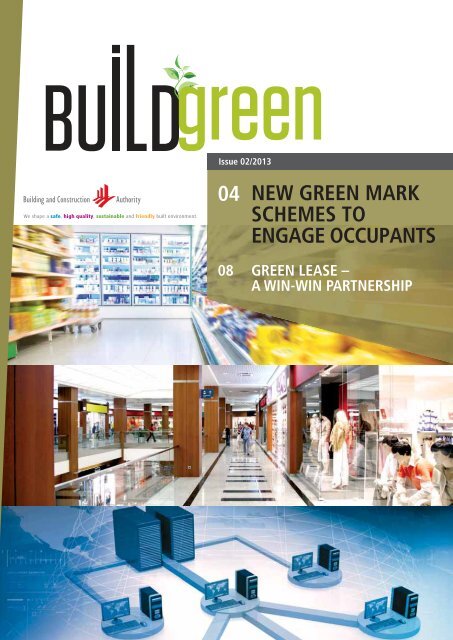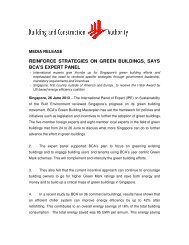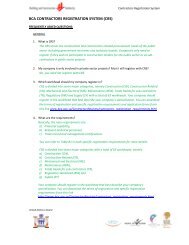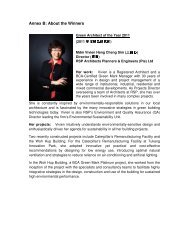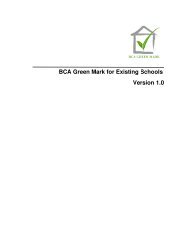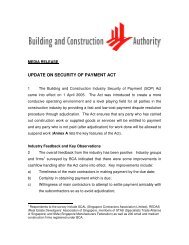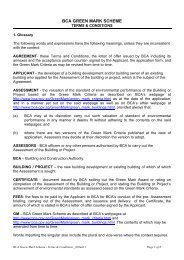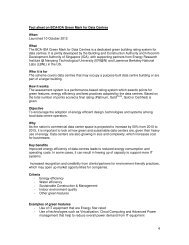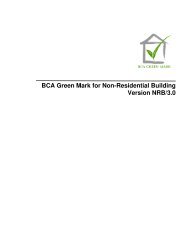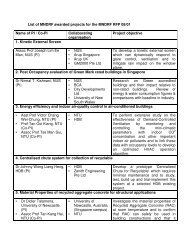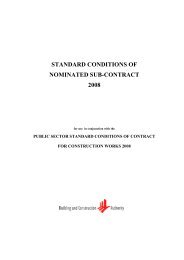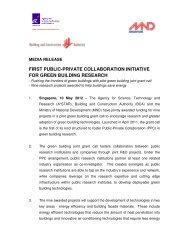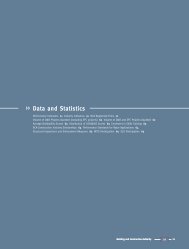02/2013 - Building & Construction Authority
02/2013 - Building & Construction Authority
02/2013 - Building & Construction Authority
You also want an ePaper? Increase the reach of your titles
YUMPU automatically turns print PDFs into web optimized ePapers that Google loves.
Issue <strong>02</strong>/<strong>2013</strong>0408NEW GREEN MARKSCHEMES TOENGAGE OCCUPANTSGREEN LEASE –A WIN-WIN PARTNERSHIP
CHIEF EDITORSTan Tian ChongAng Kian SengASSISTANT EDITORSJeffery NengLeong-Kok Su MingToh Eng ShyanSerene PehCONTENTSADVISORSJeanna DasLeong Ee LengCONTRIBUTORSArchana BalasubramaniamBenjamin HuangChan Soo ChengChoo See LokeChou Wei MengFern ZhengGrace Cheok-ChanJolene ChongJune BekKong Jia HngLeow Yock KengLim Chan BoonLim San TengLow Giau LeongRaymond WongSonam MahajanTan Li SirhThomas PangWendy LiWong Ngian ChungZhang XiutingZhou XuSPECIAL THANKSEr Tay Cher Seng (Natflow Pte Ltd)National Environmental Agency (NEA)Dr Ho Nyok Yong(Samwoh Corporation Pte Ltd)DESIGNED BYPurplecircledesignWe would like to hear from you if youwould like to share any best practices andlatest technologies that could improvesustainability or you would like us toinclude you in our delivery mail list, pleaseemail us at bca_enquiry@bca.gov.sgBuild Green Magazine is published by<strong>Building</strong> and <strong>Construction</strong> <strong>Authority</strong>5 Maxwell Road#16-00 Tower blockMND complexSingapore 069110Tel: 1800-342 5222 Fax: 6325 4800Website: http://www.bca.gov.sgWritten permission must be obtained fromBCA to reproduce any part of Build Green.Printed on non-laminated Recycled PaperGREEN HIGHLIGHTS<strong>02</strong> Learning Journey to Greenbuild03 Benchmark your Office <strong>Building</strong>’sCooling Load04 New Green Mark Schemes toEngage Occupants08 Green Lease – A Win-WinPartnership09 Enhanced Criteria for New <strong>Building</strong>sSPURRING THEPRIVATE SECTOR10 Value in GreenPROMOTING R&D INENVIRONMENTALSUSTAINABILITY11 R&D Framework12 Optimal Usage of Concrete14 A Living LabPROFILING SINGAPORE &RAISING AWARENESS15 BCA Green Mark is a Singapore Gem16 Quest for Green <strong>Building</strong> Champions17 The Time is Now18 How far are we from our nationaltarget of 80%?
CEO’sMESSAGEBest wishes for <strong>2013</strong>, andwelcome to the secondedition of Build Green. Manyof you gave us a positivereception when welaunched the inauguralissue at the InternationalGreen <strong>Building</strong>Conference 2012. Withyour feedback andencouragement, we willcontinue sharing moreknowledge, best practicesand updates to support yoursustainability journey.The green building movementis certainly gaining momentumin Singapore and drawinginternational accolades. On herrecent visit to Singapore,UNFCCC Executive Secretary MsChristiana Figueres was full ofpraises for our country’s effortsin mitigating climate change,particularly singling out our BCAGreen Mark scheme forcommendation. We were veryhonoured to be given theopportunity to present our 2ndGreen <strong>Building</strong> Masterplan andthe suite of Green MarkSchemes to complement ourpolicies and measures to Ms Figueres on hervisit here, under the International Organisations DistinguishedVisitors Programme.Indeed, we have been taking the Green Mark scheme further, bybecoming the first in the world to mandate minimum environmentalsustainability standards for existing buildings. Green Mark is notconfined to just new and existing buildings; it is also being adoptedby parks, restaurants, office interiors, infrastructure and otheraspects of our built environment now. In this issue, you will findout why we have extended the scheme from October 2012 tocover data centres, supermarkets and retail outlets, traditionallyconsidered to be major consumers of energy. By taking the industrythrough these occupant-centric schemes, coupled with GreenLease initiatives by developers, we are moving towards not onlycreating, but operating low-carbon buildings for Singapore’s builtenvironment sector.Internationally, we continue to share best practices with othercountries. We participated in the recent Greenbuild 2012International Conference and Expo in the United States, and ledindustry delegations on learning journeys to Seoul and SanFrancisco. In both cities, we engaged with local agencies andstakeholders to learn and share our experience on improvingenergy efficiency and reducing energy consumption.In this issue, you will also read about other areas of progress ingreening our built environment. Find out more about our Research& Development (R&D) Green <strong>Building</strong> Framework, developed inconsultation with multiple stakeholders as a guide to help theindustry focus its efforts. We have since made two grant calls forR&D projects.Not to be missed is the article on how property valuations shouldfactor in green building energy performance. We will also shareon the enhanced set of criteria for Green Mark Version 4.1, whichtook effect on 15 January. Finally, we have already started ourpreparations for the International Green <strong>Building</strong> Conference<strong>2013</strong>. Look out for more information on this!Dr John KeungChief Executive Officer01
GREEN HIGHLIGHTSLEARNING JOURNEY TOGREENBUILD 2012 –VISIT TO 101CALIFORNIAA 14-MEMBER SINGAPOREDELEGATION, LED BY BCA’S CEODR JOHN KEUNG FINDS OUT HOWTHIS 30-YEAR OLD SANFRANCISCO BUILDING SHINES INENVIRONMENTAL SUSTAINABILITY.101 CaliforniaCompleted in 1982, 101 California is a 48 storey building withfloor area of approximately 116,000 square metres. In spite ofits age, at about 30 years old, the building was awarded the LEED-EB OM Platinum in 2011, with the highest score ever awarded inthe Existing <strong>Building</strong>s category then.Hines, the local real-estate company which developed and managesthe building, had set its sight on the Platinum award right fromthe beginning. To achieve this goal, the in-house LEED team lookedinto every credit possible under the LEED-EB criteria, dedicating10 months solely on the project and paying special attention tothe finest detail.In the area of energy efficiency, the building had performed well.101 California is 42% more energy-efficient, saving US$1.45 inenergy costs per square foot annually, when compared to theaverage office building in the country.The few retrofits the building underwent over the last 15 to 20years also helped in its LEED certification. Some of the measuresimplemented in the retrofits included the retro-commissioning ofthe entire building, the implementation of green cleaning standardsand the introduction of a comprehensive recycling and compostingprogram.The building further adopted the continuous commissioningprogramme to ensure its systems continued to operate at optimallevels. The 30-year-old chiller plant system efficiency was wellmaintained at 0.78 kW/RT due to the low ambient temperatureand the immaculate care by the facilities management team. Wenote that the GM criteria set for system aircon efficiency is onpar with the international best practices (See Table 1 below).Green Mark RatingCertifiedGoldGoldPlusPlatinum<strong>Building</strong> Cooling Load (RT)< 500 ≥ 500Efficiency (kW/RT)0.85 0.750.8 0.70.75 0.680.7 0.65Table 1: BCA’s Green Mark Rating (for Existing <strong>Building</strong>)BCA’s Green Mark sets a more stringent requirement of at least 0.75kW/RT for water cooled chilled water air conditioning systems.
GREEN HIGHLIGHTSThe building management also engaged its tenants in the greenmovement by offering its proprietary GREEN OFFICE for Tenantsprogramme. This programme was designed to assist tenants inreducing their carbon footprint through enhancing the sustainablefeatures and operations of their rented spaces. HinesGO (GREENOFFICE) for Tenants was rolled out at 101 California in April 2009and to date, approximately 82% of the property’s leased squarefootage has been certified GREEN OFFICE.The building has truly displayed exemplary commitment towardssustainability from its initial development to operations stage,none of which would have been possible without the strongmanagement commitment, the clear targets and goals and thecooperation from the staff.The BCA delegation with the Hines Team at 101 CaliforniaThe Singapore delegation visited San Francisco and Seoul from 7 to 17 November 2012to meet with local government agencies and to visit iconic green buildings, such as 101California. The delegates ended the tour by attending the Greenbuild 2012 InternationalConference and Expo held in San Francisco.BENCHMARK YOUROFFICE BUILDING’S COOLING LOAD<strong>02</strong> / 03THESE ENERGY AUDIT RESULTS COMPILED BY THE BUILDING AND CONSTRUCTION AUTHORITYAND THE NATIONAL ENVIRONMENT AGENCY ON EXISTING OFFICE BUILDINGS SERVE AS AREFERENCE FOR BUILDING DESIGNERS, OWNERS AND OCCUPANTS IN MANAGING THEIR AIR-CONDITIONING DEMAND.In a typical air-conditioning design for office building projects,the design peak cooling load is usually in the range of 100-180W/m 2 for sizing air-conditioning equipment at peak load. However,the actual cooling load may be lower due to the diversity of airconditioningusage and various contingencies adopted incalculating design cooling load. Most of the time, buildings donot run at the design peak load, so it is important to design theair-conditioning system such that it runs efficiently even when itis operating at part load conditions, for both new buildings orretrofitted existing buildings.COOLING LOAD/AIR-CON AREA (W/m 2 )Private SectorPublic SectorOverall (35 projects)RANGE61 – 9460 – 9860 – 98AVERAGE757876The following cooling load data is obtained from energy audits ofexisting office buildings (mix of private and public sectors), duringnormal office operating hours. The cooling load per air-conditionedfloor area is in the range of 60 W/m 2 to 98 W/m 2 . This data may beaffected by seasonal changes due to measurements at differenttimes of the year. It may be used for reference but is not meant tobe used for air-conditioning design and sizing.
GREEN HIGHLIGHTSNEWGREEN MARK SCHEMESTO ENGAGE OCCUPANTSBCA’s Green Mark schemes for buildings assess the environmental sustainability ofbuildings and focus on landlords’ contributions in ‘going green’. However, tenants,who consume about 50% of the total energy used in commercial buildings, also playa substantial role in greening a building. Recognising this, BCA extended its GreenMark schemes to tenants between 2010 to 2011, by introducing Green Mark schemesfor Office Interiors and Restaurants. Then last October, BCA further introduced a suiteof new occupant-centric schemes to promote Green Mark in supermarkets, retailoutlets and data centres. Find out more on how tenants can leverage these threelatest schemes to do their part for a greener Singapore.
GREEN HIGHLIGHTSRefrigeration display cases with doorsBCA GREEN MARK FOR SUPERMARKETSThe BCA Green Mark for Supermarket scheme was developed topromote and recognise environmentally friendly and sustainablepractices and features in supermarket operations. The schemeaims to reduce the operators’ energy load, water use and wasteproduction, over and above the base building consumption forgreater energy efficiency.Four supermarkets have been certified Green Mark to date. Outof the four outlets, FairPrice Finest at Zhong Shan Park wasawarded the highest Platinum award, while FairPrice Finest atmyVillage in Serangoon Gardens received the Gold Plus award.• Energy EfficiencyEnergy efficiency is the key focus is in the Green Mark forSupermarket certification criteria. A supermarket in Singaporeuses an average of 1,300 kWh of electricity per square metre,costing S$30 per square foot, each year. For an average-sizedstore, this equates to S$300,000 annually in energy costsand results in 650 tons of carbon dioxide being emitted intothe atmosphere.Refrigeration and lighting account for over 50% of total energyconsumption in a supermarket, where the floor area rangesfrom 500 to 4500 square metres, making these systems thebest places to start looking for energy efficiency opportunities.• Environmental ProtectionThe National Environmental Agency 2005/2006 Annual Reportstated that Singaporeans used about 2.5 billion plastic bagsevery year, representing some 19,000 tones of total wasteannually.In a bid to minimise the impact to the environment, the BCAGreen Mark for Supermarket scheme awards points tooperators for their efforts to reduce, reuse and recycle itemsor materials such as cardboards, paper and plastic bottles.The operators will also be recognised for implementing apriority “green” checkout lane to serve only consumers withtheir own recycle bags. As an example of a best practice toreduce waste, the FairPrice Finest supermarket at myVillagein Serangoon Gardens implemented a priority checkout laneto serve only shoppers who brought their own recycle-bags.• Sustainable supermarket operationsThe new BCA Green Mark scheme received strong supportfrom major operators such as NTUC FairPrice and Cold Storagewho participated in the pilot schemes. Going forward, a trulysustainable supermarket operation should educate consumerson behavioural changes to minimise their carbon footprintand embrace the green journey as a possible way to improvethe bottom line.04 / 05In order to achieve the Platinum or Gold Plus award, thesupermarket outlet should have doors fitted in at least 75%of its remote refrigeration display cases and compressorscontrolled by variable frequency drives and electronicexpansion valves for the evaporators.‘FairPrice Finest’, certified Green Mark Gold Plus , saved more than10% in energy consumption by retrofitting and installing doorsto 98% of the outlet’s refrigeration display cases. Furthermore,the entire store’s 872 square metres floor area has been fittedwith LED lighting inclusive of display cases, auto zonal lightingcontrols and occupancy sensors to conserve energy.
GREEN HIGHLIGHTSCredit Suisse Regional Data CentreBCA-IDA GREEN MARK FOR EXISTING DATACENTRESData centres are heavy users of energy and are expected toincrease their energy footprint further with the rapid growth ofcloud-based services, online media and transactions. Accordingto the Infocomm Development <strong>Authority</strong> (IDA), Singapore’s 10largest data centres are estimated to consume energy equivalentto 130,000 households. The Singapore commercial data centrecapacity is projected to increase by 50% from 2010 to 2015 witha corresponding increase in energy consumption.The BCA-IDA Green Mark for Existing Data Centres is a jointcollaboration scheme between BCA and IDA to benchmark theperformance and rate the greenness of data centres. Using a pointscoring system, it assesses data centres on energy efficiency, waterefficiency, sustainable construction and management, indoorenvironmental quality and other green features. The certificationis valid for three years after which the project has to apply for recertificationif it wants to maintain the Green Mark logo.• Credit Suisse Data CentreAwarded the new BCA Green Mark Platinum Rating forExisting Data Centres, this data centre was constructed asa five-storey purpose-built light industrial building. It iscapable of meeting the data centre growth projections forthe next 25 years based on reasonable growth rates anddesigned to be modular in nature to minimise initialconstruction cost.The certification recognised its use of info-communicationequipment with Energy Star rating and energy metering toprovide total facility power and energy usage and totalequipment power to determine the PUE energy efficiencynumber. It also uses bi-level lightings, with a lighting sensorcontrol for each row of server racks, and provides a facilityfor the collection and storage of recyclable wastes such asplastic, metal and paper waste.Equinix SG 2 Data Centre Hall• Equinix SG 2 Data CentreThis co-location data centre service provider received theBCA Green Mark Gold Plus Rating for Existing Data Centres aswell as the SS564 certification: Singapore Standard for GreenData Centres – Energy and environmental managementsystems. It occupies two levels, each with its own facilitysystem to provide power and cooling.It is also equipped with bi-level lightings with lighting sensorcontrol at each row of server racks and energy metering forenergy efficiency. In addition, it uses NEWater for its coolingsystem and other non-potable water requirements.• Singapore Tourism Board Data CentreThis enterprise data centre adopted some of the best practicesfor data centres in energy efficiency management. It achieved90% in power train efficiency, defined as the efficiency of theelectrical power supply system in providing the required levelof redundancy while maintaining high load factors. It alsoemploys energy metering to monitor energy efficiency levels.For its efforts, it was awarded the BCA Green Mark GoldRating for Existing Data Centres as well as the SS564certification: Singapore Standard for Green Data Centres –Energy and environmental management systems.
GREEN HIGHLIGHTSJ’s Hair Studio at ITE College EastBCA GREEN MARK FOR RETAILThe retail sector is one of the highest consumers of energy perfloor area in Singapore. Data collected from retail buildingsassessed under the Green Mark schemes showed that tenantswithin a retail mall accounted for approximately 50% of thebuilding’s total energy consumption.The Green Mark for Retail is developed to recognise the effortsof individual retail tenants for their sustainability efforts. Thescheme aims to guide and encourage tenants to fit out their shopsin a sustainable manner that reduces operating costs and energyconsumption while maintaining the required aesthetics.Lighting energy is a major contributor to a tenant’s electricitybills and is the largest energy component that is fully withinthe control of a tenant. J’s Hair Studio was installed withenergy efficient T5 and LED lighting to cut down on lightingenergy consumption. It also zoned lighting circuits to switchoff lights in specific areas when not in use.The owners at J’s Hair Salon went further to incorporategreener methods in the daily operations to counter theperception that the industry was a resource-wasting one.Simple innovations now allow the stylists to work effectivelywith less electricity and water.06 / 07Since its launch, the scheme has certified three retail outlets,namely J’s Hair Studio at ITE College East, Royal Silver at 313Somerset and Dressaday at 313 Somerset. Going forward, BCAintends to work closely with major retail developers to encourageenvironmentally friendly design among tenants during the fit-outrenovation stage.• Greening a hair salonBCA Green Mark Gold Plus recipient, J’s Hair Studio, was openedin 2011 at ITE College East. The owners had designed thesalon with a strong objective to adopt eco-friendly featuresat this outlet. Having taken over the shop space from aprevious tenant and to minimise materials wastage, a largeportion of the flooring, ceiling and light fixtures were retainedduring the fit-out process. The eco-friendly retail design alsoincluded recycling and reusing wood panels and aluminumpanels as part of the furniture.To involve customers in the green movement, the salon alsointroduced programmes for customers to recycle their usedcontainers as well as including environmentally friendlyproducts in their sales product line-up. A video clipdocumenting environmentally sustainable procedures inrunning a hair salon was also produced and distributed toother hair salons.To download the detailed criteria for these new occupant-centric Green Mark Schemes, please go to:Data Centres: http://www.bca.gov.sg/GreenMark/others/GM_DC_v1.pdfSupermarkets: http://www.bca.gov.sg/GreenMark/others/GM_s_v1.pdfRetail Outlets: http://www.bca.gov.sg/GreenMark/others/GM_Retail_v1.pdf
GREEN HIGHLIGHTSGREEN LEASE –A WIN-WIN PARTNERSHIPENJOY THE MUTUAL BENEFITS OF GREEN LEASE BY ENGAGINGTENANTS THROUGH A BUILDING MANAGEMENT COMMITTEE.Last year, BCA rolled out a full suite of occupant-centric GreenMark Schemes to bring occupants onboard the green movement.In addition to the various occupant-centric Green Mark Schemes,building owner can further engage the tenants on going greenthrough a green lease, which provides a mutual lease agreementfor building owners and tenants to minimise environmental impactin their daily operations and share benefits such as annual savingsfrom utilities bills and healthy indoor environment.Although building owners such as Lend Lease, CapitaLand andMapletree have successfully signed green leases with some oftheir tenants, green leases have yet to gain significant traction inSingapore’s commercial leasing market. From BCA’s industryconsultations, the key hurdles appear to be tenants’ perceivedconflicts of interest as well as their lack of knowledge and essentialexpertise in environmental sustainability. Having said that, KeppelLand is confident that with tenants being better educated on theappreciable benefits of green leasing, green leases will gainincreasing acceptance in the industry.To make green leases work more effectively for all parties, theBetter <strong>Building</strong>s Partnership in London recommends the formationof a <strong>Building</strong> Management Committee. A <strong>Building</strong> ManagementCommittee brings together the representatives of both the buildingowner and tenants to set targets and review the environmentalperformance of the buildings periodically.Case Study: Hollywood HouseThe Better <strong>Building</strong>s Partnership cites Hollywood House, a retrofittedfive-storey office building in London, as a successful case study.Between 2010 and 2011, Prudential Property Investment Managers(PRUPIM) carried out extensive refurbishment works to HollywoodHouse.The refurbishments substantially improved the energy performanceof Hollywood House by replacing the inefficient mechanical andelectrical systems. At the same time, PRUPIM established a <strong>Building</strong>Management Committee to work closely with tenants tounderstand the building’s performance and to drive towardsenvironmental improvement.With this joint effort, one of the tenants, Skanska, has madetremendous environmental improvements in using 56% less energyper square metres than before the refurbishment. The companyalso enjoys an annual savings of about £28,000 in its operationcosts.Picture: Hollywood HouseSource: Prudential Property Investment Managers Limited (PRUPIM)Win-Win PartnershipFrom London’s example, it follows that having a common goaltowards a sustainable built environment could help attain a winwinpartnership for building owners and tenants. The <strong>Building</strong>Management Committee provides an ideal platform to fostereffective communication, address obligations and concerns andbuild the mutual understanding and agreement needed as afoundation to a green lease. Once the green lease is in place,building owners and tenants would be encouraged to collaboratefurther to adopt green practices in their buildings in the future.1Source of Case Study: Better <strong>Building</strong>s Partnership,www.betterbuildingspartnership.co.uk
GREEN HIGHLIGHTSENHANCED CRITERIA FORNEW BUILDINGSFROM 15 JANUARY, THE BCA GREEN MARK FOR NEW BUILDINGS WILLADOPT AN ENHANCED CRITERIA SET OUT IN GREEN MARK VERSION 4.1.THIS SETS TO ENHANCE THE ADOPTION OF RESOURCE-EFFICIENT DESIGNAND PRACTICES. HERE ARE THE KEY CHANGES, AS HIGHLIGHTED IN THEBCA CIRCULAR ISSUED ON 31 OCTOBER 2012.• Scoring methodology for building cooling systemefficiencyThe methodology in determining the system efficiency ofbuilding cooling system was revised to be based on the totalaverage cooling load and total power inputs of the varioussystem components or on the energy modelling frameworkwhere applicable.• Sustainable productsThis will be an additional pre-requisite for minimum pointscoring under Sustainable Products for higher awards.• Sustainable <strong>Construction</strong>This enhancement will allow more flexibility in terms ofscoring for lower usage of recycled materials• Energy modelling frameworkThe assessment will consider passive design enhancementsand small air distribution systems in the energy savingcomputation.• Energy-efficient equipment or productsThe new criteria will consider the use of energy-efficientequipment or products that are certified to be environmentallyfriendly.• Ventilation Simulation MethodologyThe minimum pre-requisite will be relaxed to require only70% of selected typical units with optimal air flow. Theventilation simulation can be based on two best prevailingwind directions.All Green Mark applications for new buildings that aresubmitted on or after this date will be assessed and certifiedbased on this version. Projects that are submitted prior to15 January but not assessed by 15 October this year will alsobe subject to Green Mark Version 4.1 automatically.08 / 09More details on Green Mark Version 4.1 can be found at :Circular to Professional Institutes /Associations:http://www.corenet.gov.sg/einfo/Uploads/Circular/CBCA121031.pdfhttp://www.corenet.gov.sg/einfo/Uploads/Circular/CBCA121031_01.pdfBCA Green Mark Certification Standard for New <strong>Building</strong>s, GM Version 4.1, Oct 2012 Issue:http://www.bca.gov.sg/EnvSusLegislation/others/GM_Certification_Std2012.pdfCode for Environmental Sustainability for <strong>Building</strong>s3rd Edition, Oct 2012 issue:http://www.bca.gov.sg/EnvSusLegislation/others/Env_Sus_Code2012.pdf
SPURRING THE PRIVATE SECTORVALUE IN GREENTHE SINGAPORE INSTITUTE OF SURVEYORS AND VALUERS HAS PUBLISHEDA NEW VALUATION GUIDELINE ON GREEN BUILDINGS TO HELP VALUERSCONSIDER ENERGY-EFFICIENT FEATURES WHEN VALUING PROPERTIES.The Singapore Institute of Surveyors and Valuers published avaluation guideline to take green building features intoconsideration when assessing market value. While the methodsof valuation used will still remain the same, the new guidelinewill make the valuer more aware and account for the green factorswithin each development, where applicable. (This guideline is apublication and copyright of SISV.)• Direct Comparison MethodUnder this method, green buildings should be appraised bycomparing them to similar green buildings which have beensold, and making the relevant adjustments for differencesbetween comparable properties. The direct comparison methodcan also be applied when assessing the rental of greenbuildings. With more green buildings and developmentsbeing built, this method will become more relevant.• Cost MethodThe cost method will give the valuer an indication of thevalue enhancement of green features to property value. Abuilding certified Green Mark Platinum may be more costlyand likely more valuable than one that is Green Mark certifiedif other characteristics of the two properties are similar.well as reduction in operating expenses. The income methodmay be in the form of a direct capitalisation method usingthe prevailing rental multiplied by the years of purchase ora discounted cash flow over an appropriate period takinginto account the expected useful life of the green features.THE GUIDELINE WAS INTRODUCED AT THEBREAKFAST TALK FOR CEOS JOINTLY ORGANISEDWITH BCA ON THE LAST DAY OF THE SINGAPOREGREEN BUILDING WEEK 2012. SENIORPARLIAMENTARY SECRETARY FOR DEFENCE ANDNATIONAL DEVELOPMENT, DR MOHAMAD MALIKIBIN OSMAN WAS THE GUEST-OF-HONOUR FORTHE EVENT.• Income MethodUnder the income method, the correct net income should beestimated taking into account the enhancement it may achieveas a result of the incorporation or installation of green featuresand design. This could be in the form of increased rental as“Green buildings have a tremendous impact on value, image and operational efficiency. Thereis a need to assess the enhancement in the value and benefit of green buildings. The proposedSISV Guideline on Valuation of Green <strong>Building</strong>s provides the framework for determining theirappropriate market values,”Professor Lim Lan Yuan, President of Valuation & General Practice,Singapore Institute of Surveyors and Valuers.
PROMOTING R&D IN ENVIRONMENTAL SUSTAINABILITYR&D FRAMEWORKTO GREEN THE BUILT ENVIRONMENTA GREEN BUILDING R&D FRAMEWORK HAS BEEN ESTABLISHED TO HELPSINGAPORE GREEN 80% OF OUR BUILDINGS BY 2030.The Inter-Ministerial Committee on Sustainable Development forSingapore’s built environment had set the target. At least 80%of the buildings in Singapore should achieve BCA Green MarkCertified rating by 2030.Although BCA had rolled out its 2nd Green <strong>Building</strong> Masterplanin 2009 with a focus to green the large stock of existing buildings,it recognised that it could still be a technical challenge to retrofitthese buildings cost-effectively and with minimum disruption. Toaddress this challenge, the Green <strong>Building</strong> R&D Workgroup,supported by BCA’s R&D Programmes department, establishedthe Green <strong>Building</strong> R&D Framework as a guideline for grant calls.The Framework seeks to achieve three desired outcomes – resourceefficiency, energy efficiency and liveability (live, work, play). Ituses the life-cycle of a typical building as a basis to identify thekey R&D focus areas. To determine its practicality and priority,each technology will be assessed in terms of its impact towardscarbon abatement, economic potential, resource security andcompetitive advantage.The workgroup developed the Framework in consultation withacademia and industry. It included inputs from representatives ofthe Ministry of National Development, Housing & DevelopmentBoard, Urban Redevelopment <strong>Authority</strong>, National Parks, A*STAR,SPRING Singapore, JTC Corporation, Economic DevelopmentBoard, Infocomm Development <strong>Authority</strong>, Energy Market <strong>Authority</strong>and National Environment Agency.With the Framework in place, a pilot R&D grant call was madetogether with A*STAR and the Ministry of National Developmentin 2011 on energy efficient and building materials. A total of $9million was awarded to nine projects. Following this success, BCArolled out a second joint R&D grant call, specifically in the areaof high-performance building façade materials. The award isexpected in the first half of <strong>2013</strong>.For more information about the Framework, please visitwww.bcaa.edu.sg/GB_RnD_framework.aspx or emailbca_research@bca.gov.sg for your enquiries and feedback.10 / 11Reference: http://www.bcaa.edu.sg/cmsresource/img_research/GB_RnD_Frameworkr4.pdf
PROMOTING R&D IN ENVIRONMENTAL SUSTAINABILITYOPTIMAL USAGE OFCONCRETETHE GUIDEBOOK TITLED ‘SUSTAINABLE CONSTRUCTION – A GUIDE ONCONCRETE USAGE INDEX’ IS NOW AVAILABLE TO THE INDUSTRY.BCA has published its sixth guidebook under the Sustainable<strong>Construction</strong> series on the optimal usage of concrete. It was puttogether collaboratively with contributions and reviews from keyindustry stakeholders and the academia, working together topromote sustainable construction.The guidebook showcases several projects with inputs fromrespective project teams on how they achieved a good concreteusage index scoring. These projects also achieved good buildabilityscores, demonstrating the general alignment between concreteusage index, productivity and buildability. The publication alsoidentifies useful technologies and methodologies for structuraland non-structural systems, to achieve the objective of design foroptimal usage of concrete at the upstream.To facilitate the concrete usage index calculation, several existingcommercially available software, such as <strong>Building</strong> InformationModelling tools and Structural Analysis Engines, were introducedin the guidebook. Such software can automatically extract therelevant quantities such as volume of material used and constructedfloor area, both of which are needed for computation of the indexvalue. Like all other software, BIM tools and analysis enginescould be used to their fullest potential to ease CUI calculationsonly when the modellers are experienced and adequately trained,in order to model building elements and define the material andboundary conditions such as the constructed floor area, correctly.Ms Grace Fu Minister, Prime Minister’s OfficeSecond Minister For The Environment And WaterResources, Second Minister For Foreign Affairs“BCA has teamed up with academia and industry to develop a guide on Concrete Usage Index,which will be shared here at this conference to raise awareness and to share best practicesamong industry practitioners.”The guidebook was launched on 10 October 2012 at the opening of Singapore Green <strong>Building</strong> Week,with more than 400 copies were distributed over three days. The online version is available fordownload at www.bca.gov.sg/Sustainable<strong>Construction</strong>/others/sc_cui_final.pdf
PROMOTING R&D IN ENVIRONMENTAL SUSTAINABILITYSUSTAINABLECONSTRUCTION:RCA FOR STRUCTURALAPPLICATIONSDr Ho Nyok YongDR HO NYOK YONG, DIRECTOROF SAMWOH CORPORATION,DISCUSSES THE CHALLENGESOF CONSTRUCTING THESAMWOH ECO-GREENBUILDING USING CONCRETEWITH 100% RECYCLEDCONCRETE AGGREGATES.Question: Is it true that recycled concrete aggregates (RCA) areinferior in quality compared to natural aggregates making themonly suitable for non-structural works?Dr Ho: In general, there is a lack of confidence in the quality of RCAand consequently, its application in structural concrete. Quality in RCAis highly determined by the existence of proper and stringent controlin the RCA quality during processing. With few projects adopting RCAin structural building works previously might also contribute to theslow rising numbers of using RCA for structural applications.Question: Could the cost of RCA as compared to natural aggregatesbe a deterrent factor?Dr Ho: The cost is not one of the deterrent factors for the use ofRCA in structural application. In fact, the price of RCA has beenvery competitive as compared to natural aggregate. We areoptimistic that there will be more projects adopting RCA instructural building works with the many schemes such as GreenMark scheme put in place by BCA to encourage industrystakeholders.Question: What are the challenges faced when undertaking SamwohEco-Green <strong>Building</strong> project? How did you overcome them?Question: What are some of the features that help Samwoh Eco-Green <strong>Building</strong> to achieve low concrete usage index?Dr Ho: We have achieved a good concrete usage index value of0.33 for the building. Although concrete with RCA was used forthe key structural elements – which included columns, beams,slabs, lift cores and staircase cores – the internal non-structuralwalls were constructed using dry walls and hollow-core wallsmade of fine RCA. For the building façade, a special type ofperforated aluminium curtain wall was used to reduce the heatand allow natural daylight to enter the building.Question: Moving forward, are you planning any research anddevelopment activities for green concrete?Dr Ho: Samwoh has been relentlessly looking into the feasibilityof using different types of recycled wastes for constructionapplications even before sustainable development took flight inSingapore. The efficient utilisation of coarse RCA in structuralconcrete is definitely not an end to our sustainable journey butan opening to a new chapter. Moving forward, we will exploreother potential wastes that can be recycled from the waste stream.12 / 13Dr Ho: The studies on the use of RCA in concrete were not newthen, but they are mostly confined to laboratory scale and limitedliterature was available. As such, the practicability of using RCAconcrete and its performance in actual building were uncertainand doubtful. Even though the BS EN standard has already allowed20% replacement of RCA in structural concrete, there are concernson the possible adverse impacts.We managed to address the various issues through extensivelaboratory tests to evaluate the material properties such aspermeability and creep of concrete. We also implemented advancedstructural monitoring device like the fibre-optic sensors in keystructural elements in columns to monitor the actual behaviour ofthe building. These initiatives were made possible by the supportfrom the MND Research Fund administrated by BCA. Now, SamwohEco-Green <strong>Building</strong> stood strong and became the first building inthe region to achieve up to 100% replacement of RCA in structuralconcrete works, which has effectively demonstrated the feasibilityof using high percentage of RCA in structural concrete and to furtherboost the confidence of the industry.
PROMOTING R&D IN ENVIRONMENTAL SUSTAINABILITYA LIVING LABTHE BCA ZERO ENERGY BUILDING IS A LIVING LAB FOR THE TESTING OFGREEN BUILDING TECHNOLOGIES.The BCA Zero Energy <strong>Building</strong> is already a living example of howthe smart integration of green building technologies and solar PVtechnologies can lower and meet the building’s energy demandyet achieve a net zero energy balance. For more than three years,the building has been consuming less electricity than what isproduced by the solar panels.In addition, the Zero Energy <strong>Building</strong> can accommodate the testingof innovative green building technologies in a real buildingenvironment with active occupants. Such testing can allow solutionproviders to evaluate the performance of green buildingtechnologies in order to make suitable adaptions to improve theirperformances for use in tropical buildings.A cool test bedEr Tay Cher Seng was one innovator drawn to the building’s proenterpriseplatform to perfect his work on a cooling technologythat allows cold air to be delivered to building occupants bynatural convection means, without relying on fans. At Zero Energy<strong>Building</strong>, he test-bedded his innovative Passive DisplacementVentilation (PDV) system within a classroom setting.The system bears a unique design to stratify the room space intodifferent temperature zones. As the cooling coils cool the warmair near the ceiling, the chilled air drops within the shaft to bedischarged at the bottom, thus creating a cold air reservoir at thefloor. As the cold air picks up heat from human bodies, it rises tothe ceiling to be cooled by cooling coils before the cycle repeatsagain. The temperature stratification creates a comfortable zonefor room occupants without wasting energy cooling the upperhalf of the room.After performing his test in December 2011, Er Tay Cher Sengfound that the system had more than met the thermal criterionof 24°C and 60±5%RH. The chart below shows the temperatureat several locations inside the room to be 24°C and the relativehumidity markedly below 55%. A smoke test also showed thatthe cold air driven by natural convective force was distributeduniformly and effectively. In the occupants survey, 90% of theoccupants surveyed indicated acceptance of the ambientenvironment generated.This result was shared at the ASEAN Energy Summit in 2012 andthe PDV system won a coveted award in the special category forinnovation. One of the first adopters of this technology is the NTUOffice of Development & Facilities Management. After visiting thePDV classroom at the Zero Energy <strong>Building</strong>, the NTU Office ofDevelopment & Facilities Management became an early adopterof the PDV system to perform a pilot test on campus before fullimplementation at its new eight-storey NTU Learning Lab.PDV integrated in the closetIf you are interested in ZeroEnergy <strong>Building</strong>’s test-beddingfacilities, please submit yourproposal detailing thetechnology, test methodology,cost and timeline to BCA’sCentre for Sustainable<strong>Building</strong>s and <strong>Construction</strong> forconsideration. Furtherenquiries may be directed toMs Alice Goh atalice_goh@bca.gov.sg orMr Stephen Mok atstephen_mok@bca.gov.sg.Temperature and Relative Humidity in the PDV classroom
PROFILING SINGAPORE & RAISING AWARENESSBCA GREEN MARK IS ASINGAPORE GEM“I am only beginning to understand whatSingapore is doing on climate at the nationallevel. I am impressed by the breadth and thedepth of the efforts”~ Ms Christiana FigueresThe ‘Little Red Dot’ received the world’s top climate change officialon 18 and 19 October 2012. Ms Christiana Figueres, the ExecutiveSecretary of the United Nations Framework Convention on ClimateChange (UNFCCC) was here at the invitation of the Minister forthe Environment and Water Resources under the InternationalOrganisations Distinguished Visitors Programme.A Costa Rican, Ms. Figueres was appointed Executive Secretaryof the UNFCCC by UN Secretary-General Ban Ki-moon on 17 May2010. She has also served on several boards of non-governmentalorganizations involved in climate change, including the VoluntaryCarbon Standard.On the first day of her visit, BCA and the National Climate ChangeSecretariat presented on Singapore’s Climate Change strategies.Ms Figueres found out more about the landmark legislation ongreening existing buildings, which was highlighted as a key leverto drive minimum environmental sustainability in existing buildingsand to ensure building energy systems were operated andmaintained at optimal levels.districts to parks and office interiors to restaurants – to complementits policies and measures. She lauded BCA for its efforts in drivingsustainability in the built environment; in particular the GreenMark schemes for all buildings.During her visit, Ms Figueres gave a lecture on “Climate Change:Why We Need a Multilateral Solution” to government delegates,industry leaders, the media, and students. At the lecture, sheextolled Singapore’s efforts, emphasising that the tiny islandcountry was punching above its weight. However, she also pointedout that as with the rest of the world, more could always be donelocally. Driven by either national interests or global necessity,countries needed to accelerate and widen their horizons when itcame to climate change. She further edified the audiences to be“heavyweights” to secure a sustainable tomorrow that futuregenerations could depend on.Over the years, BCA’s local industry stakeholders had workedclosely with the government to support the green buildingmovement in Singapore. With our national commitment to reduceemissions by 7% to 11% from the 2<strong>02</strong>0 BAU level and to achievethe 80% target to green buildings, there is still much work to bedone. This would require further collective public-private effortsin various aspects of the green building movement as well asindustry leaders taking the lead in building up their green collarworkforce and research capabilities in new and innovativetechnologies.14 / 15With this new requirement, Singapore was the first in the worldto mandate a minimum standard in the built environment to meetthe national target of greening 80% of the building stock.Ms Figueres also learnt about how BCA had introduced a suiteof Green Mark schemes – ranging from new to existing buildings,“We are not there yet, but I suggest toyou that the climate change process iscreating that paradigm, with muchdifficulty and not at Formula One speed,but we are on our way.”~ Ms Christiana FigueresSource: Part of the article first appeared in Climate Challenge, a bi-monthlye-newsletter on climate change produced by the National Climate Change Secretariat.Other active roles that Ms Figueres has played overthe decade:-• Represented Latin America and the Caribbean on the ExecutiveBoard of the Clean Development Mechanism in 2007• Served as Vice President of the Bureau of the Conferenceof the Parties 2008-2009.• Founded and directed the Centre for SustainableDevelopment of the Americas (CSDA) between 1995 and2003, a non-profit think tank for climate change policy andcapacity-building.• Served as Director of the Technical Secretariat, RenewableEnergy in the Americas (REIA) from 1994 to 1996.
PROFILING SINGAPORE & RAISING AWARENESSQUEST FORGREEN BUILDINGCHAMPIONSRECOGNISING OUTSTANDINGINDIVIDUALS IN THE GREENBUILDING INDUSTRYBCA, in partnership with the Singapore Green <strong>Building</strong> Council(SGBC), introduced the BCA-SGBC Green <strong>Building</strong> IndividualAwards in 2011 to honour outstanding individuals from the builtenvironmentsector for their achievements and contributions tosustainable development in Singapore. The Awards serve tomotivate our green professionals to challenge their limits indeveloping innovative green building solutions.“The introduction of these awards is testament to the firmcommitment of government and industry stakeholders to recognisethe contributions of these outstanding individuals in green buildingspractices,” Mr Tai Lee Siang, President of the SGBC, explains. “Itis also our ardent wish to encourage talented individuals to aspiretowards greater heights in creating a sustainable global city.”Since its launch in 2011, eight outstanding green buildingindividuals have been awarded for their strong commitment andconviction in propelling environment sustainability in their owncapacity. The conviction of these passionate individuals to protectand improve the environment has injected new purpose andmeaning into the built environment careers in order to attractmore newcomers and retain existing talents.Sharing his thoughts on green buildings, Mr Eugene Seah, whowon the Green Advocate of the Year 2012, said: “Sustainablebuildings need not necessarily cost excessively more. Throughoutmy career I have value engineered and brought projects back tobudget with similar or higher sustainable rating in Green Markand other rating tools. I enjoy looking for sustainable value toadd in projects, be it economic, environment or social.”Mr Seah advocates the importance of going green in his personaland professional capacity. He has a passion for developing greenbuildings and has worked on master planning sustainable projectslike the Jurong Lake District, the Zero Energy <strong>Building</strong> and FoshanSustainable City in China. Serving in institutions and committees,both locally and regionally, he hopes to further uplift the sustainableparadigm of the industry.What’s new for <strong>2013</strong>?This year, in its third run, the search is on for green championswho befit these accolades. Apart from the four main categorieswhich are for Advocate, Architect, Engineer and Innovator, a newcategory, the “Young Green <strong>Building</strong> Individual Award” isintroduced for the first time. This award recognizes the contributionsof promising young professionals to the green building sector.Applicants below the age of 40 years old will be automaticallyeligible when they apply for any of the four main categories.Details on the application for the BCA-SGBC Green<strong>Building</strong> Individual Awards can be found onwww.bca.gov.sg/gbia/bcasgbc_gbia.html. For moreinformation, please contact Mr Tan Soo Huat (tel: 6325 5<strong>02</strong>2,email: tan_soo_huat@bca.gov.sg ) or Ms Fern Zheng (tel: 63255924, email: fern_zheng@bca.gov.sg).Meet Our Past WinnersWinners for Year 2012Green Advocate Green Advocate Green Architect Green InnovatorMr. Eugene SeahDeputy Chairman, Langdon & Seah SingaporePte Ltd/Director, Langdon & Seah ProjectManagement Pte LtdMr. Tan Phay PingManaging Director, <strong>Building</strong> System andDiagnostics (BSD) Pte LtdMr. Tang Kok ThyeAssociate Partner, ADDP Architects LLPEr. Tay Cher SengManaging Director, Natflow Pte LtdWinners for Year 2011Green Advocate Green Engineer Green Architect Green InnovatorMr. Allen AngDeputy General Manager, Projects and Head,Green <strong>Building</strong>, City Developments LimitedEr. Tan Kiat LeongExecutive Director, Beca Carter Hollings &Ferner (S.E. Asia) Pte LtdMdm. Vivien HengDirector, RSP Architects Planners & Engineers(Pte) LtdDr. Ho Nyok YongTechnical Director/ Director, SamwohCorporation Pte Ltd
PROFILING SINGAPORE & RAISING AWARENESSTHE TIME ISNOWBCA CEO DR JOHN KEUNGSTRESSES THE URGENCY FORENGINEERS AND BUILTENVIRONMENT PROFESSIONALSTO SUPPORT SUSTAINABILITY ANDGREEN GROWTH NOW.In the second edition of a series of lead-up events for the WorldEngineers' Summit <strong>2013</strong> held on 13 December 2012 at SIMUniversity, Dr Keung joined Dr Christopher Hails, Chairman ofWWF Singapore, to address 300 participants. He outlined therelevance of an accelerating worldwide green economy to engineersand built environment professionals and stresses upon industryrepresentatives on the growing global impetus for a moreresponsible building construction and maintenance regime.“There has never been a better time than now to ride the waveof global green growth,” he said. “With our reputation as one ofthe key green building leaders of Asia, our firms and builtenvironment engineers and professionals are well-positioned toplay their part in a rising green economy while assuming thecritical role of mitigating the impact of climate change, urbandevelopment and rising energy consumption on the environment”.Participants were also encouraged to build up their capabilitythrough green-related programmes such as the Green MarkManager or Professional courses at BCA Academy. At the sametime, firms could build up their pool of green building expertiseto sharpen their competitive edge locally and overseas.A frequently heard comment is that it is expensive to retrofit anexisting building to achieve Green Mark certification. Based ona study on “Valuation of Green <strong>Building</strong>s” jointly conducted byBCA and NUS in 2011, the average retrofitting cost works out tobe only about 2% of a similar new building. If the retrofit cost isexpressed as a percentage of the current market value of property,the cost is even smaller at around 0.4% for retail and 0.77% foroffice.In addition, the key benefit of obtaining a Green Mark certificationis the significant reduction in the consumption of energy. Theaverage savings from the sample after retrofitting are about 17%savings of the total building’s energy consumption compared tobefore retrofitting.Block the dates on your calendar forIGBC <strong>2013</strong>The International Green <strong>Building</strong>Conference (IGBC) <strong>2013</strong> will be heldalongside the World Federation ofEngineering Organisation GeneralAssembly, the World Engineers' Summit<strong>2013</strong>, the Sustainable <strong>Building</strong>Conference <strong>2013</strong> (SB13) among otherinternational green building events from9 to 15 September. The co-location ofthese major events is aimed atcapitalising on the convergence of thecommunity of industry professionalsincluding architects, engineers,consultants and developers to networkand make contacts while attendingdedicated events based on specificinterests.16 / 17
PROFILING SINGAPORE & RAISING AWARENESS2030 | 80% (Target)<strong>2013</strong> | 17.7%2004 | 0%PERCENTAGEOF GREENBUILDINGS INSINGAPOREAS AT JANUARY <strong>2013</strong>


